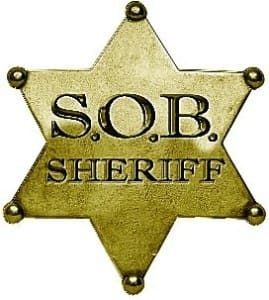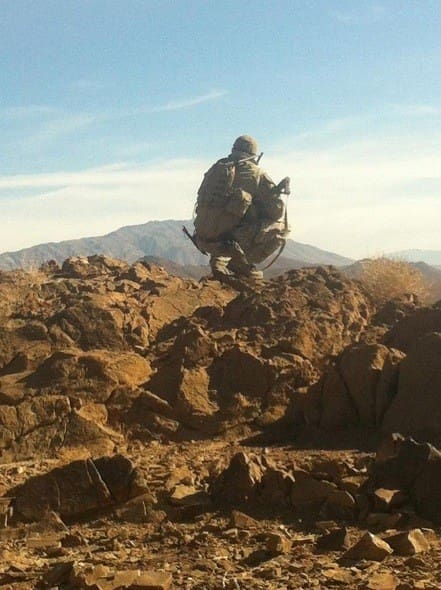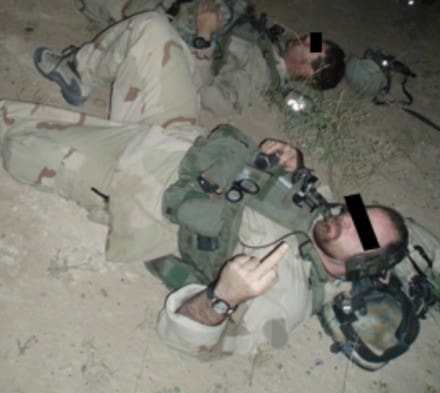Non-verbal communication is the most over looked and misunderstood tool that Warriors have. In today’s world, you say what you want and you get it. It begins at a young age but everyone realizes that when asked what he wants to eat, a child will respond verbally. However, as you grow, you begin to take non-verbal cues. For example, as a Warrior in battle, you’ll see the Warrior to your left shooting. What does that tell you? It says “he is engaged with the enemy.” You look to your right and you see a Warrior on his back with another kneeling over him? Possibly wounded or worse. It gives a mental snap shot of what is going on around you and what you should do, or need to do, next. No words need to be exchanged nor would there be time but even if there was time, you wouldn’t hear it due to distance or the sounds of battle. This non-verbal communication, through good training, can be, hands down, better than verbal communication. However, we generally train and use verbal communication because of lack of knowledge, understanding, and experience. Besides, it’s just easy to do. Yep, finger drill training, talk me through it, and I’ll call you trained. Sad but true, so weak and lazy leaders beware! I’m watching you!
Train using non-verbal comms because in gun fights you won’t have the time to bullshit. Guns are loud so you won’t be able to hear anyway, and if you’re listening for someone to say something, you’re not focused on the fight. This lack of focus puts your life, my life, and the lives of the Warriors around you at risk. Not cool hammy hands, so listen up. Remember, you need to wear ear protection at all times. Otherwise, it’s, “In a gun fight today as a warrior and def tomorrow because of it.” If you’re deaf, how will you tell your stories over beer to score chicks? So, wear your ear pro. All leaders train with ear pro, that way it takes the “talk me through it” out of your training.
As a young Ranger I was in the Sniper section which as you know, is in the same platoon as the Anti-Tank gunners. Those guys shot the 90mm Recoilless everyday and later switched to the 84mm Carl Gustav. These hand cannons are LOUD, HEAR ME? So these AT gunners couldn’t uses verbal comms for two distinct reasons. 1. Both the Recoilless and ‘Goose’ are too LOUD to hear anything. 2. The gunners were all deaf due to reason number one. That’s right, deaf. It was so bad that before any mandatory hearing tests those boys would wear ear plugs all weekend or longer just to pass. THEY KNEW NON-VERBAL COMMUNICATION. CAN YOU HEAR ME?!
Train using non-verbal comms. Start today. It’s easy, and it ain’t rocket surgery*. If you see a possible enemy or a threat, point your rifle at it. If all the Warriors on your team, patrol, or whatever see this, they know you see a possible enemy. When you lower your rifle, the threat is gone. Simple, right? Makes total sense. Rifle “up” threat, rifle “down”, no threat. Yeah, I said it again for the not so bright guys in the back row (best guys in a gun fight, the backrowers). So we’re out patrolling, I bring my rifle up and start shooting. This means, “shit’s on sucker.” Then I stop shooting and lower my weapon and wait…………. Wait for it……. “Shits off.” That’s right. So you’re still with me? Good.
So now we’re in a gun fight, and you’re bounding. Yeah, that’s a 3 to 5 second rush, remember that? I’m up, bad guy sees me, I’m down. When you’re down, as your buddy, I’m moving. When I’m down, I’m covering your movement. This can be done in any size element. The old standby, conventional method is to use verbal comms to say shit like “cover me, moving, ready, clear, roger, balls, bullshit” or what ever the F your using. Look, if I move, you see me run, then I’m down. How long will it take for me to cover you? Two seconds after I drop from your view. So wait two seconds and move. And, once again, if there is shooting, you won’t hear all this bullshit anyway. In and around buildings, cars, urban areas, even without shooting, you won’t hear it. So why try use it? Again, we are a buddy team and you don’t hear me say “move”, do you wait 10 minutes? or forever? No, you look around, realize I am covering you and rush. Then it all starts over again. Except, you’ve probably been victim to standing around waiting for the new guy that is lying in wait to be told to move for 10 minutes. This is an indicator that your methods and training sucks! Just try it you’ll see. If you have any combat experience at all you’ll realize you can’t hear that shit anyway. Plus, this also affords you speed (oh yeah bonus). Ok Rangers, I was taught speed is not security but when bringing steel to bear on your enemy, the quicker the better…Amen.
I feel like you’re starting to get my drift, so I will give one more example. Clearing rooms and buildings, close quarters battle (CQB), that sort of stuff. When you enter and clear a room guys say, “clear, red zone, you suck, dick” or whatever, right? Yeah this shit is hitting close to home, huh? Well hear me out. You come into the room rifle up and clear your sector of fire. Rifle down meaning my sector is clear and I’m ready to move. So four guys in a room, rifles down, means room “clear” without saying a word. Best of all, you will lower your rifle to move anyway, true? So this makes it all that much easier. Think about this scenario. You’re taking a room off a street to get out of a worse situation. There’s still shooting going on outside this room because war is loud suckers. That’s why you wear ear protection. But, ear pro and talking don’t mix. Am I right? So YOU WON’T HEAR the four clears you need to move on, so do not waste the time your going to do it anyway no verbs style. So train for that easy (yes easy). Do it, and start today! Start doing this now, it’s easier than you think if you train for it, and most of all, stop making excuses. Don’t be a weak ass leader!
-Shrek
 SGM (ret) John McPhee served a distinguished career in U.S. Army Special Operations for over 20 years, retiring in 2011.
SGM (ret) John McPhee served a distinguished career in U.S. Army Special Operations for over 20 years, retiring in 2011.
John has spent his adult life in Special Operations and Special Mission Units. He is a Master Instructor in all aspects of special activities, missions and operations. He has over 6 years of private special activities consulting and is a Subject Matter Expert (SME) in: Special Activities, Operational Preparations, Limited Signature Operations, Reconnaissance, Singleton Operations, High Threat Dignitary Protective Services, Extreme Long Range, Designated Marksman, Advanced Precision Rifle Marksmanship, Combat Marksmanship, Live Fire CQB/CQC, Advanced Pistol Marksmanship, Advanced Carbine Marksmanship, Aeriel Gunnery (Rifles, Shotguns, Ariel Personnel and Vehicle Interdictions, Mechanical, Ballistic and Explosive Breaching, Freefall Instructor Programs, Infiltration/ Exfiltration Techniques, Ground Mobility, Unit Pre-Deployment Training, and Research and Development of; Soldier Systems, Weapons, Ammunition, Thermal and Night Optics.
Qualifications;
Special Forces Target Interdiction Course
US Army Sniper School
NRA Rifle, Pistol and Shotgun, Instructor
NRA Range Safety Officer
Advanced Mountain Sniper Course, Instructor
Advanced Freefall, Instructor (Ratings Current)
Freefall Coach (Ratings Current)
California Personal/ Executive Body Guard Certification (Rating Current)
2005 Budweiser World Cup Super Heavyweight Jiu-Jitsu Champion
2004 Presidential Security Detail (Ariel Heavy) Cartagena, Colombia
He has trained countless U.S. Special Operations forces, thousands of International Tier 1 Operators and Special Forces around the world. He is one of the handful of operators with over a decade of combat having served in multiple theaters from Bosnia and South America to recent war efforts in Iraq and Afghanistan.
Gunfighter Moment is a weekly feature brought to you by Alias Training & Security Services. Each week Alias brings us a different Trainer and in turn they offer some words of wisdom.
*”Rocket surgery” is a Shrekism created by combining the best elements of rocket science and brain surgery into a new field of study which Shrek mastered as a young Ranger. Today, many aspire to learn the secrets of this arcane form of martial science under the tutelage of Shrek.
Tags: Alias Training and Security Servives, John McPhee, Shrek




THIS is what a Gunfighter Moment should be! Good, sound advice from someone who has BTDT.
Excellent post, please post more of these.
Sir, your article around hearing protection is excellent! I’m a consultant supporting the DoD Hearing Center of Excellence and we’re working to promote hearing conservation (hearing.health.mil). Would you be willing to chat with me briefly? I beleive you could help us by contributing a very credible voice — as a legitimate warrior with real world experince — to influence military members about hearing protection. Respectfully, Brendan Smith
Of course I will help! Contact me any time.
Thank you so much! I’ll drop you an email shortly through your info address at Alias Training to connect. Best regards!
I remember our first shoot and move drills when we used to say ‘no hearing protection’ so everybody could hear his buddy saying ‘move’/’bounce’. It was clear it was stupid as soon as the first loud shot was fired.
Thank you so much for a big piece of practical advice for any Warrior. Hearing protection is important and a good one is better.
Took a few classes at Bragg from this large fellow on TSE, CQC, and CQB. This is free advice from one of the gnarliest warriors I’ve ever learned from.
Never hide the SGM’s pants.
Solid advice. I’ve been saying the same thing for years. However, why is it that people still teach to yell a bunch of unnecessary BS like “CONTACT” & a clock direction and distance or “MOVING”, “CHANGING MAGAZINES”…I saw a video once where a dude yelled “STANDING” to his buddy and his buddy yelled “STAND”. It seems like insecurities drive guys to default to what some other idiot trained them to do.
It’s not unnecessary BS. Yelling contact is to let everyone know what is going on. It’s also not just “contact”, but “contact left etc.” So that everyone can orient to the threat- and it’s a command that is repeated. I’ve been hit while out with 25+ pers. At a proper interval, the last 10 pers will not know what is happening up front without an indication. Also, the clockray method is to put EVERYONE onto a target. If you have four dudes in a team no problem, but if you are looking to get EFFECTIVE fire onto an enemy then everyone needs to be on the same page.
Same deal for “moving” “breaching (once you are no longer silent)” etc. I was standing next to a soldier who almost had his head blown clean off by the debris from an explosive breach across an alley. He is alive because by chance I said something to him and he turned to speak to me and pulled his head out of the alley. He almost died because the other group didn’t have situational awareness.
Interesting stories. So When your 25+ element began engaging, it was only because you guys were yelling that a portion of them were able to understand the direction they were to orient themselves? I’m curious as to why they wouldn’t understand which direction to engage after seeing their mates shooting. Interesting stories though bro.
Hmm. So the guy who gets up right as his buddy is putting the last .5 of pressure on his trigger and is going to take a solid-copper decongestant… maybe “STANDING” wasn’t so stupid, yeah?
“STANDING” probably wouldn’t be so stupid if I were shooting in/around someone that didn’t have the situational awareness to remove that last .5 of pressure on his trigger when I stood up. Like I said, insecurities…
‘Sides, if you’re going to stand up, it’s your responsibility to check your 6. Clear your front and sides, then check rear before moving so you don’t eat the bullet in your back.
The phrase “Rocket Surgery” is NOT a “shrekism”. It’s old, it’s been around in Army circles for decades, and it’s not something anyone “invented”.
Secondly, the “wait 2 seconds” and then move is a bad idea. What if your team mate went down because he was shot? Now you have no cover and you are also dead. You need to look- yes, and if they are engaging then you move- also you can listen for them to fire (yes you can hear with earpro in). If there is too much fire, you need to maneuver and confirm that the enemy is suppressed before you are out in the open.
Moving without confirmation is a last ditch, take a chance and shit your pants action. I don’t care who says it’s a good idea.
meh, I would take the opinion of a guy who’s probably done hundreds of missions during GWOT pretty seriously.
In my opinion, waiting for those confirmations is like putting your thinking and actions on hold. You put yourself on hold waiting for them to answer a question you most likely know the answer to. Unless your teammate is brain damaged, they’re probably suppressing. If they aren’t, they should tell you why. Instead, you could concentrate on the task at hand and get shit done.
If your teammate went down, I’d think you’d know….something about him screaming that he’s hit. Yeah, you should call out if you’re loading or your gun goes down cause those are legitimate. But asking permission to move every time you need to does seem a bit redundant and wasteful.
It’s not about ASKING permission. It’s about confidence and confirmation.
Assuming that someone is suppressing is a good rule, but It’s best to be certain. I have seen all manner of weapons go down when required, even the trusty old 870 I carried for CQB failed me once, I couldn’t believe it. I have also seen that most of the time there aren’t any failures, and your teammate will cover you.
It’s not about them being brain damaged, it’s about a weapons malfunction, or sand in his face. And not everyone that gets shot starts screaming, sometimes it’s the “silent scream” of so much pain and confusion that they can’t react the way they have planned.
Yes, I have experience these things, and am simply trying to further discussion.
Dear Canada Dude. Please don’t take things to Literal! For everytime I’ve done something in combat, there was a time where the same thing might get you killed. This is the nature of the beast. If its your day to die, then it’s the day you go home and you should be thankful!
For training these are more solid principals than most train with today. Food for thought and glad that you are thinking things through. If the worse thing that happens today is your sceptical about my post well today was still an awesome day for me!!!
Sent from hunting in a ground blind in S TX.
Fair enough reply. I like that your article is about thinking things through. My response was simply based on my experiences. I agree that training for a “REAL” fight means that you have to plan for poor comms etc.,
I agree about things working one day, and not the next, the battelfield is all about adaptation.